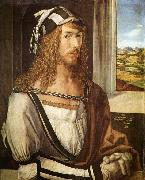Wholesale Oil Painting No Minimum |
|||||||||||
|
|
|||||||||||

|
|||||||||||
|
|
|
||||||||
Albrecht Durerb.May 21, 1471, Imperial Free City of Nernberg [Germany] d.April 6, 1528, Nernberg Albrecht Durer (May 21, 1471 ?C April 6, 1528) was a German painter, printmaker and theorist from Nuremberg. His still-famous works include the Apocalypse woodcuts, Knight, Death, and the Devil (1513), Saint Jerome in his Study (1514) and Melencolia I (1514), which has been the subject of extensive analysis and interpretation. His watercolours mark him as one of the first European landscape artists, while his ambitious woodcuts revolutionized the potential of that medium. D??rer introduction of classical motifs into Northern art, through his knowledge of Italian artists and German humanists, have secured his reputation as one of the most important figures of the Northern Renaissance. This is reinforced by his theoretical treatise which involve principles of mathematics, perspective and ideal proportions. His prints established his reputation across Europe when he was still in his twenties, and he has been conventionally regarded as the greatest artist of the Renaissance in Northern Europe ever since. |
||||||||
|
|
||||||||
Self-Portrait at 26
Self-Portrait at 26 Painting ID:: 63730 |
1498 Oil on panel, 52 x 41 cm Museo del Prado, Madrid This self portrait is dated 1498 and inscribed: `I have thus painted myself. I was 26 years old. Albrecht D?rer.' Since the artist turned 27 on the 21 May, the picture must date from the beginning of the year. The artist's pose is self confident, showing him standing upright and turning slightly to lean his right arm on a ledge. D?rer's figure fills the picture, with his hat almost touching the top. His face and neck glow from the light streaming into the room and his long curly hair is painstakingly depicted. Unlike his earlier self portrait, he now has a proper beard, which was then unusual among young men. Nine years later D?rer wrote an ironic poem in which he described himself as `the painter with the hairy beard'. The artist's clothing is flamboyant. His elegant jacket is edged with black and beneath this he wears a white, pleated shirt, embroidered along the neckline. His jaunty hat is striped, to match the jacket. Over his left shoulder hangs a light-brown cloak, tied around his neck with a twisted cord. He wears fine kid gloves. Inside the room is a tall archway, partly framing D?rer's head, and to the right a window opens out onto an exquisite landscape. Green fields give way to a tree-ringed lake and beyond are snow-capped mountains, probably a reminder of D?rer's journey over the Alps three years earlier. Depicting a distant landscape, viewed through a window, was a device borrowed from Netherlandish portraiture. The Germans still tended to consider the artist as a craftsman, as had been the conventional view during the Middle Ages. This was bitterly unacceptable to D?rer, whose second Self-Portrait (out of three) shows him as slender and aristocratic, a haughty and foppish youth, ringletted and impassive. His stylish and expensive costume indicates, like the dramatic mountain view through the window (implying wider horizons), that he considers himself no mere limited provincial. What D?rer insists on above all else is his dignity, and this was a quality that he allowed to others too. This picture was acquired by Charles I of England and later bought by Philip IV of Spain.Artist:D?RER, Albrecht Title: Self-Portrait at 26 Painted in 1501-1550 , German - - painting : portrait 1498 Oil on panel, 52 x 41 cm Museo del Prado, Madrid This self portrait is dated 1498 and inscribed: `I have thus painted myself. I was 26 years old. Albrecht D?rer.' Since the artist turned 27 on the 21 May, the picture must date from the beginning of the year. The artist's pose is self confident, showing him standing upright and turning slightly to lean his right arm on a ledge. D?rer's figure fills the picture, with his hat almost touching the top. His face and neck glow from the light streaming into the room and his long curly hair is painstakingly depicted. Unlike his earlier self portrait, he now has a proper beard, which was then unusual among young men. Nine years later D?rer wrote an ironic poem in which he described himself as `the painter with the hairy beard'. The artist's clothing is flamboyant. His elegant jacket is edged with black and beneath this he wears a white, pleated shirt, embroidered along the neckline. His jaunty hat is striped, to match the jacket. Over his left shoulder hangs a light-brown cloak, tied around his neck with a twisted cord. He wears fine kid gloves. Inside the room is a tall archway, partly framing D?rer's head, and to the right a window opens out onto an exquisite landscape. Green fields give way to a tree-ringed lake and beyond are snow-capped mountains, probably a reminder of D?rer's journey over the Alps three years earlier. Depicting a distant landscape, viewed through a window, was a device borrowed from Netherlandish portraiture. The Germans still tended to consider the artist as a craftsman, as had been the conventional view during the Middle Ages. This was bitterly unacceptable to D?rer, whose second Self-Portrait (out of three) shows him as slender and aristocratic, a haughty and foppish youth, ringletted and impassive. His stylish and expensive costume indicates, like the dramatic mountain view through the window (implying wider horizons), that he considers himself no mere limited provincial. What D?rer insists on above all else is his dignity, and this was a quality that he allowed to others too. This picture was acquired by Charles I of England and later bought by Philip IV of Spain.Artist:D?RER, Albrecht Title: Self-Portrait at 26 Painted in 1501-1550 , German - - painting : portrait |
|||||||
|
CONTACT US |

